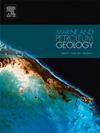Seafloor thermal structures controlled by recent slope failure and fluid flow: An example from offshore SW Taiwan
IF 3.7
2区 地球科学
Q1 GEOSCIENCES, MULTIDISCIPLINARY
引用次数: 0
Abstract
Ubiquitous bottom simulating reflections (BSRs) on seismic profiles indicate the presence of gas hydrates and free gases in both the active and passive margins offshore SW Taiwan. Detailed seafloor temperature measurements and modeling were conducted in offshore SW Taiwan gas hydrate provinces to investigate the thermal structure under dynamic gas hydrate systems. We performed seismic analysis, direct temperature measurements, and BSR-based thermal modeling to understand the seafloor thermal structures and subsurface fluid flow systems. First, seismic interpretation was applied to understand the BSR distribution and structural features in the gas hydrate provinces along the convergent plate boundary offshore SW Taiwan. Then, we compiled the 159 in-situ temperature measurements in marine sediments, and a regional heat flow map was proposed. After that, we use the sub-bottom depths of the widespread BSRs to derive seafloor thermal structures offshore SW Taiwan. Finally, by comparing the measured and BSR-based temperature fields, several interesting geological processes affecting the seafloor thermal structures are revealed. The distinct heating effects near the lower slope of the accretionary prism indicate active fluid flow along the thrust and décollement systems. In the upper slope, the seafloor thermal structure shows an overall low with local higher heat flow near the diapiric structures, implying that the diapirs may serve as active fluid conduits. Although few large-scale fault systems exist in the passive South China Sea (SCS) Slope, the upward fluid migration along normal faults, dipping strata, and gas chimneys contribute to intense local-scale seafloor heating. Apparent thermal nonequilibrium observed near the deformation front reveals a recent mass transport deposit (MTD) event with a volume of ∼0.8 km3. Our results present the geologically controlled seafloor thermal structures under the dynamic gas hydrate systems, which may give insights into the subsurface fluid flow, gas hydrate systems, and submarine geohazards.
求助全文
约1分钟内获得全文
求助全文
来源期刊

Marine and Petroleum Geology
地学-地球科学综合
CiteScore
8.80
自引率
14.30%
发文量
475
审稿时长
63 days
期刊介绍:
Marine and Petroleum Geology is the pre-eminent international forum for the exchange of multidisciplinary concepts, interpretations and techniques for all concerned with marine and petroleum geology in industry, government and academia. Rapid bimonthly publication allows early communications of papers or short communications to the geoscience community.
Marine and Petroleum Geology is essential reading for geologists, geophysicists and explorationists in industry, government and academia working in the following areas: marine geology; basin analysis and evaluation; organic geochemistry; reserve/resource estimation; seismic stratigraphy; thermal models of basic evolution; sedimentary geology; continental margins; geophysical interpretation; structural geology/tectonics; formation evaluation techniques; well logging.
 求助内容:
求助内容: 应助结果提醒方式:
应助结果提醒方式:


